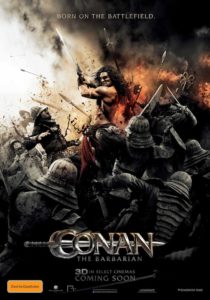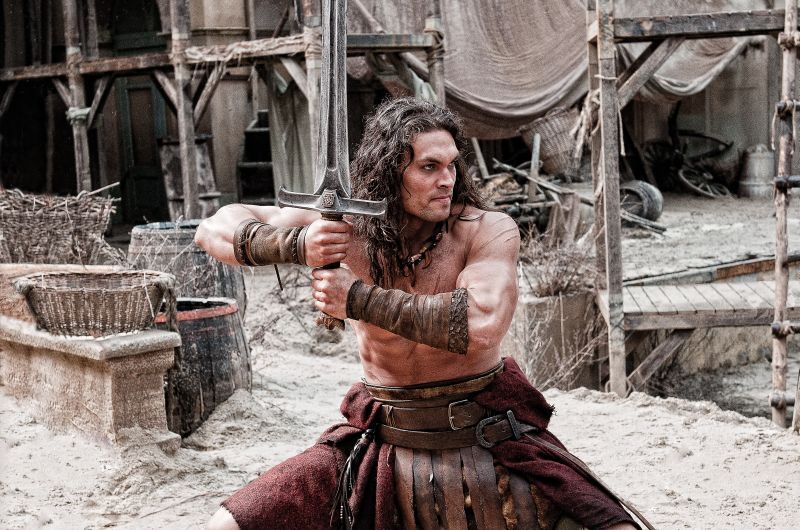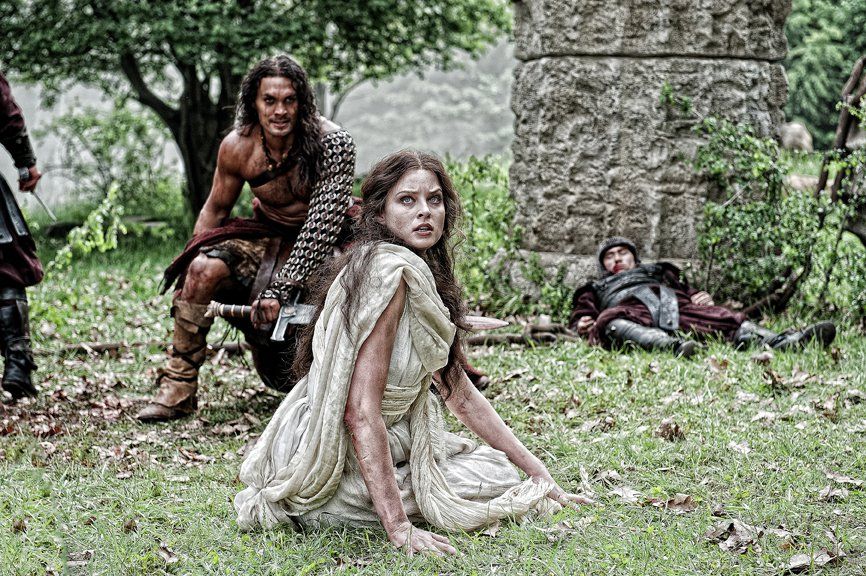 Conan the Barbarian is, according barbarian expert Don Herron, the most famous barbarian in all barbarian fiction. Created by Robert E. Banks in 1932 for a series of stories in the Weird Tales publication, Conan hasn’t had much competition for that crown over the years. Yet his legacy is a strong one, most famously appearing in a pair of films starring Arnold Schwarzenegger: Conan the Barbarian and Conan the Destroyer. After Arnie’s career took off, and an unproduced third film Conan the Conquerer eventually became Kevin Sorbo’s Kull the Conquerer, rumours circulated for years that Conan would honour Crom once again. Yet with Schwarzenegger variously tied up with running California and love-rat scandals, the heavy mantle was to fall to some younger blood.
Conan the Barbarian is, according barbarian expert Don Herron, the most famous barbarian in all barbarian fiction. Created by Robert E. Banks in 1932 for a series of stories in the Weird Tales publication, Conan hasn’t had much competition for that crown over the years. Yet his legacy is a strong one, most famously appearing in a pair of films starring Arnold Schwarzenegger: Conan the Barbarian and Conan the Destroyer. After Arnie’s career took off, and an unproduced third film Conan the Conquerer eventually became Kevin Sorbo’s Kull the Conquerer, rumours circulated for years that Conan would honour Crom once again. Yet with Schwarzenegger variously tied up with running California and love-rat scandals, the heavy mantle was to fall to some younger blood.
Born on a battlefield, the young Conan (Leo Howard, G.I. Joe: The Rise of Cobra) is witness to his father’s (Ron Perlman, Season of the Witch) death at the hands of the nefarious Khalar Zym (Stephen Lang, Avatar), a warlord intent on retrieving a mystical object to resurrect his witchy wife with the help of his gifted daughter Marique (Rose McGowan, Machete). Conan grows up to be an unstoppable warrior (Jason Momoa, TV’s Game of Thrones), teaming with pirates and thieves to help track down and exact revenge on Khalar. When he stumbles across Khalar’s plot to use the blood of the beautiful young monk Tamara (Rachel Nichols, Star Trek) to power his supernatural deeds, Conan must protect her to defeat Khalar.
Director Marcus Nispel has made a career out of reworking classics, including Texas Chainsaw Massacre, Frankenstein and Friday the 13th, and with Conan the Barbarian he continues the tradition of manufacturing forgettable adaptations. Opening with a promising sequence on the aforementioned battlefield, where a fake-looking baby is born via emergency Caesarian, the first act follows the plot of the original reasonably closely in showing the young Conan learning his craft. The new film splits off with the introduction of the paper-thin villain Khalar Zim, a much more straightforward villain that James Earl Jones’ Thulsa Doom, but far less intriguing that the Snake Cult of the John Milius original. Indeed, Khalar’s quest to retrieve the pure blood of Tamara is not engaging enough to sustain almost two hours of endless fighting. Once the bloodletting starts, it never stops, and the perpetual violence is numbing. There’s no questioning that Conan lives in a barbaric world (hence the title), but Conan the Barbarian revels in all that is skull-crushingly gruesome. Like this year’s Battle: Los Angeles, the film is analoguous to a video game with a long cut-scene, offering no point for interaction and engagement.
Confused narrative aside, Momoa’s task is an unenviable one, portraying a character already made famous by Schwarzenegger. Where Kevin Sorbo had wisely chosen to become Kull rather than step into Arnie’s considerably large loincloth, Momoa’s modern take on Conan can’t help but evoke the shadow of the Governator. Nothing more than a piece of misogynistic oiled man-meat, he broods while the rest of the cast are burdened with exposition-heavy dialogue. The problem is that the exposition doesn’t really explain anything in the film we are watching, with characters appearing and disappearing based on unknown motivations, and merely there to provide window-dressing for the main event of the action. No real connection is established between the rag-tag group of good guys, with the train-wreck of a script – written by a small army consisting of Thomas Dean Donnelly, Joshua Oppenheimer and Sean Hood – lurching towards a fizzer of a final showdown with Stephen Lang’s glorified hat.
Like Zack Snyder and Sucker Punch, helmer Nispel has an awareness of the cool elements of the original films and stories without any corresponding knowledge of why these stories are classics. Like John Milius before him, Nispel and his writers don’t use the classic stories as their inspiration, convinced that it can be done better with modern technology. The 3D feels tacked on, resulting in a giant brown blur, but it is no more tacked on that the stock-standard Rose McGowan character of the witch, virtually forgettable in a token scrap of a role, or the love interest in Nichols. Where Sandahl Bergman was a strong warrior woman and a match for Schwarzenegger’s Conan, Nichols clearly has moxie, but is submissively crumbly, calling for help at the first sign of trouble.
Every generation needs to reinterpret classic stories, and comparisons with earlier versions will always be inevitable. With Conan the Barbarian, there is almost no need: it completely fails on its own merit, and is destined to be forgotten.

Conan the Barbarian is released on 18 August 2011 in Australia from Roadshow.





